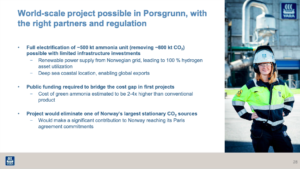The Hydrogen Council has published a valuable report with a rigorous life-cycle assessment (LCA) of greenhouse gas emissions from various hydrogen applications. It illustrates the report with eight specific examples, two of which focus on ammonia. With green hydrogen as an input to ammonia used in fertilizer production, we could deliver a 96% reduction in emissions. With blue hydrogen exported and combusted as ammonia for electric power generation, we could deliver an 84% reduction in emissions. As the report states at the start: “Life-cycle emissions are coming into focus with scaling-up of hydrogen … To deliver on the sustainability promise, it is … not only important to make it economically viable, but also maximize its decarbonization potential.”
Content by Author
Carbon intensity of fossil ammonia in a net-zero world
In discussions of carbon capture technology for low-carbon ammonia production, there are two informal rule-of-thumb numbers: 60% and 90%. We know we can capture, at very little additional cost, over 60% of the CO2 from a natural gas-based ammonia plant because this is the process gas (the byproduct of hydrogen production). Many ammonia plants already utilize this pure CO2 stream to produce urea or to sell as food grade CO2. The remaining CO2 emissions are in the much more dilute flue gas (the product of fuel combustion to power the process). For some decades we have assumed we could capture most of this but the lingering question has always been: how much of that flue gas is economically feasible to capture? A team of researchers at Imperial College London has just published a fascinating study into this question, entitled “Beyond 90% capture: Possible, but at what cost?” The paper quantifies the tipping point — ranging from 90% to 99%, depending on flow rates and concentration — beyond which it is easier to capture CO2 directly from the air than it is to capture more flue gas emissions.
Full electrification: Yara plans 500,000 tons of green ammonia in Norway by 2026
Green ammonia projects continue to be announced at dizzying speed and scale. A few weeks ago, Origin Energy disclosed its feasibility study to develop 500 MW (hydro) / 420,000 tons per year of green ammonia in Tasmania, with first production targeted for mid-2020s. This week, a consortium led by Haldor Topsoe and Vestas announced 10 MW (wind+solar) / 5,000 tons of green ammonia in Denmark, which could be operational in 2022, making it the first green ammonia plant at this scale. Also this week, Yara made a significant corporate announcement, detailing a “transformation of its commercial business models, sales channels and offerings,” with the full decarbonization of its Porsgrunn plant at the heart of its strategy to use green ammonia “to enable the hydrogen economy.”








